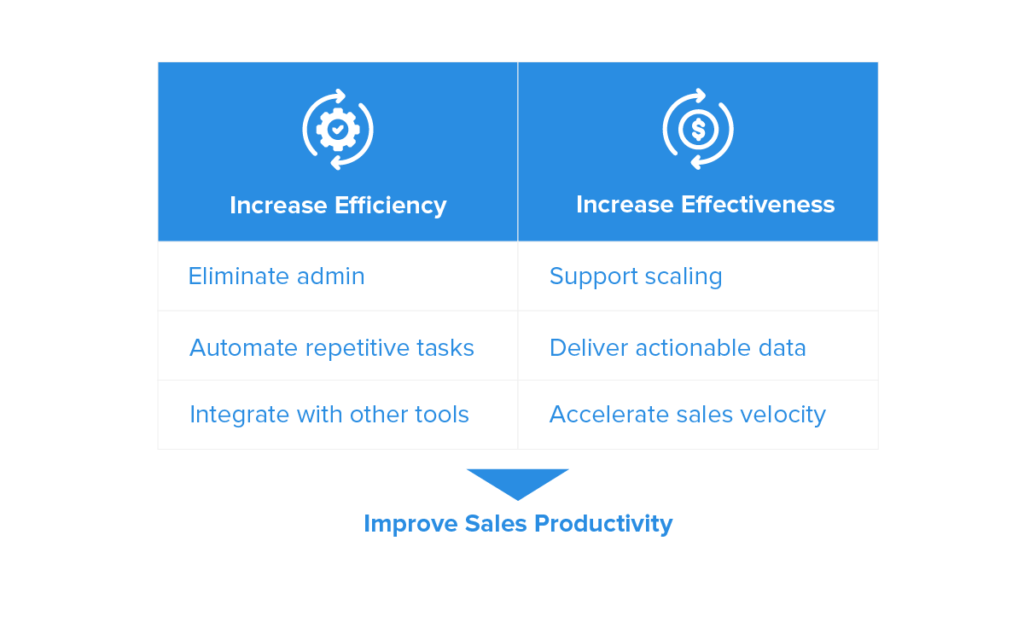The right tools can make all the difference. Just as James Bond needs his gadgets, or a baseball player needs a quality bat, sellers will be most productive with a strategic tech stack.
The sheer volume of sales software available, however, makes deciding which platforms to invest in a daunting task. That’s why you need a simple decision framework and a clear understanding of which tools can make the greatest impact.
How to Build the Best Sales Tech Stack
The framework for selecting new sales software is straight-forward: Sales tools must either increase efficiency or effectiveness — the two pillars of productivity.

Tools may accomplish these outcomes by various means, such as automation or intuitive user interfaces, but any new investment should achieve at least one, if not both, of these goals.
Keeping efficiency and effectiveness in mind, follow these steps to evaluate and invest:
- Identify a problem and determine objectives: Protect your business from unnecessary spending by ensuring each investment has a purpose.
- Examine your ecosystem: Ensure you’re building an ecosystem by looking at your tech stack holistically and considering whether new purchases provide additional value and work well with your other investments.
- Make a decision: Whittle down options using a decision matrix to rank tool capabilities against expected outcomes — Smartsheet has a useful collection of decision-matrix resources and free templates.
- Implement and optimize: Utilizing best practices, deploy your solution to your team. Carefully monitor adoption and impact and continually make adjustments to optimize.
The Five Types of Sales Tools You Need
Once you have a decision framework, use it to examine these five categories of sales tools:
- Customer Relationship Management
- Business Intelligence and Business Analytics
- Sales Enablement
- Sales Engagement
- Sales Readinesss
This is not a comprehensive list — simply the essentials you need to keep your sales team productive.
1. Customer Relationship Management (CRM)
What it is: Customer Relationship Management (CRM) technology is used to manage your company’s relationships and interactions with current and potential customers. CRM provides a top-level view of your company with data flowing in from all customer-facing teams — marketing demand campaigns, customer service interactions, and, of course, sales.
Why you need it: Manually tracking input from multiple teams for every customer interaction may be possible when you have five customers, but is impossible at scale. CRM helps you understand opportunities and risks in your current and prospective customers using data from marketing, sales, and services.
Questions to ask:
- Will this platform scale as my company grows?
- Can I record every interaction with customers and prospects?
- Can I integrate and manage marketing campaigns?
- Can I create custom dashboards and reports?
- Does this platform provide a comprehensive view of my business?
You may have heard of:
Keep learning:
2. Sales Reporting, Analysis, and Intelligence
What it is: These solutions typically come in the form of business intelligence (BI) or business analytics (BA) platforms. BI solutions transform data into an intelligent, consumable picture of your company’s present state. BA mines data for a predictive view of your company’s future.
Why you need it: Visualizations and reports from business intelligence and analytics solutions are your growth road map — telling you where you’re going based on where you’ve been. Together, they can prescribe strategic actions to drive desired future outcomes.
Questions to ask:
- Does this platform provide both BI and BA?
- Can this platform process a large volume of data accurate and efficiently?
- Are data visualizations easy to consume and meaningful?
- Can I create custom dashboards and reports?
- Does this platform integrate with my other business systems?
- Do I have the resources to manage this platform?
You may have heard of:
Keep learning:
- Analytics Comes of Age
- The Difference Between Business Intelligence vs Business Analytics Solutions
- Top 10 Guidelines for a Successful Business Intelligence Strategy
3. Sales Enablement Platforms
What it is: Comprehensive sales enablement platforms prepare sellers by providing content alongside context and ensure assets are always current and easy to find. Top tier platforms combine machine learning and artificial intelligence to understand when and how content is used.
Why you need it: Sales enablement technology gives businesses a powerful advantage by combining everything a seller needs to be effective in one easy-to-navigate platform. Analytics also provide intelligent recommendations on how sellers can best use assets, closing the loop between sales and marketing.
Questions to ask:
- How easy is it to find content? How easy is it to manage content?
- What type of analytics does the platform provide (content, user, revenue)?
- What integrations are available? Does it integrate with my CRM?
- What does a typical deployment process look like?
You may have heard of:
- Highspot (we’re biased)
- Check out G2 Crowd’s list of sales enablement tools
Keep learning:
- State of Sales Enablement 2019
- Sales Enablement PRO Directory
- 5 Features to Look for in a Sales Enablement Solution
4. Sales Engagement Platforms
What it is: Sales engagement tools help you to deliver high-quality buyer engagements by using automation to streamline workflows and eliminate routine administrative tasks.
Why you need it: When you pair sales engagement platforms and sales enablement solutions, you get a powerful combination that elevates the experience for both sellers and buyers. Specifically, we just teamed up with Groove through our latest integration, which gives joint customers the ability to insert AI-recommended content where reps are engaging buyers and comprehensive analytics on what content moves conversations forward.
Ha Nguyen, Director of Marketing at Groove, recommends, “Keep it simple. Modern businesses move so rapidly that engaging buyers with the right mix of quantity and quality is impossible if you’re juggling disparate tools. Combining Groove and Highspot gives reps everything they need to successfully prospect, engage, and close.”
Questions to ask:
- Which parts of my sales team’s workflow will this platform automate?
- Does this platform integrate with my CRM? What about email and calendars?
- How does this platform enable personalization at scale?
- Does this platform support account-based selling?
You may have heard of:
Keep learning:
- Sales Engagement – The Definitive Guide
- What Is a Sales Engagement Platform, Anyway?
- 5 Best Practices for Deploying a Sales Engagement Solution
5. Sales Readiness
What it is: Sales readiness tools deliver the training, coaching, and practice content necessary to ensure reps are productive and effective. This includes videos, quizzes and assessments, onboarding paths, playbooks, and more.
Why you need it: Preparing reps is key to ensuring that new hires ramp quickly and that current reps are prepared for any conversation they may encounter in the field. A good sales readiness tool goes beyond just classroom training to support a variety of content formats, allowing reps to learn in a dynamic, interactive environment.
Questions to ask:
- Does this platform integrate with my sales enablement solution?
- Can I easily manage a variety of content types to support dynamic learning?
- What type of analytics into rep engagement does this platform provide?
- How will this platform prepare reps for difficult conversations?
You may have heard of:
Keep learning:
- Sales Onboarding: The Key to Unlocking More Revenue
- Sales Learning and Coaching Technology: Three No-Brainer Outcomes
Invest Wisely
Now that you understand how to build your tech stack, it’s time to start exploring the tools available to you. Begin by looking at the full list of sales enablement tools in our comprehensive guide.




